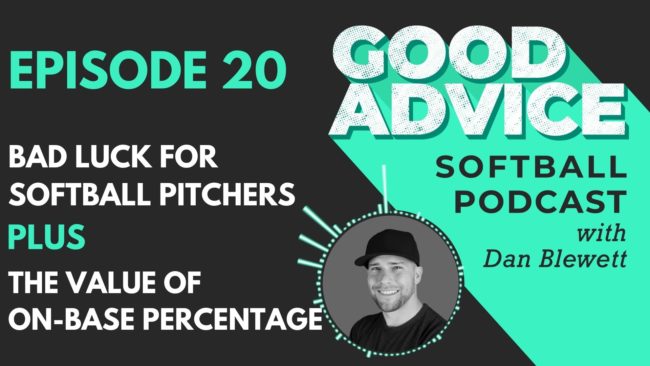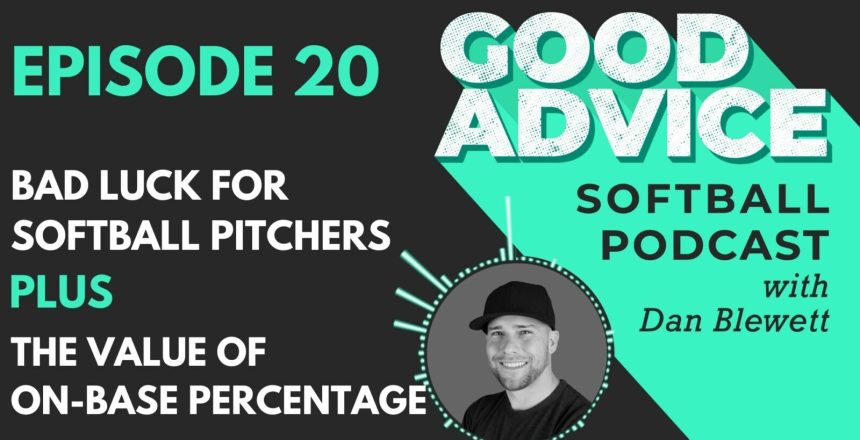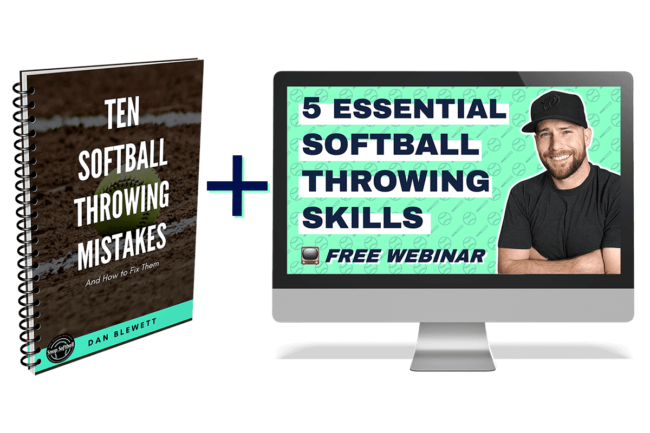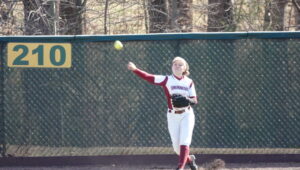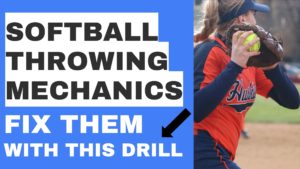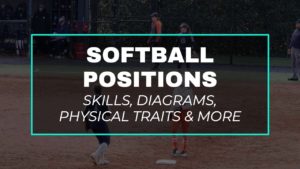*This article may contain product links which pay me a small commission if you make a purchase. Learn more.
In this episode, Dan talks through good luck and bad luck scenarios for softball pitchers. Dan also discusses the value of on-base percentage for hitters and the importance of being disciplined at the plate.
Links: Try the Early Work Strength Program for free here.
To submit a question for the Good Questions Q&A segment, make a voice recording and email it to Dan at hello@danblewett.com. Want to support the show? Enroll in one of Coach Dan’s online throwing courses or his mental skills course. Use code GOODADVICE to save 20% on any course, just for being a listener. Sign up for Dan’s Email list and get his free throwing eBook, and follow up with him on the interwebs: YouTube Channel | Twitter | Snapsoftball.com
Podcast: Play in new window | Download
Subscribe: Apple Podcasts | Spotify
EP20 Transcript: EP20 – Bad Luck for Softball Pitchers Plus The Value of On-Base Percentage
GA EP20 Final Audio
You are listening to the Good Advice Softball Podcast. I’m Dan Blewett. And on this show, you’ll learn how to help the softball player in your life. Sharpen her skills, improve her mindset and find new confidence through softball.
Welcome back to the Good Advice Softball Podcast. I’m your host. Dan Blewett on today’s show. We’ve got two topics number one. We’re going to talk a little bit about bad luck for softball, pitchers. This is obviously a thing, you know, well, if you’ve been a pitcher, if you’ve been a parent of a pitcher, but you might not realize there’s a bunch of other pieces of good and bad luck that are kind of sneaky and are actually really interesting to ponder.
So we’ll talk about that. And then number two, we’re gonna talk about on base percentage. Which I think softball probably understands better than baseball does. I think there’s still a lot of machismo in baseball about hitting your way on. But I think softball has actually been pretty good about this as far as the role of slap hitters.
And I think the sport values on base percentage probably more than baseball does, but I do want to talk about it. Because I think it’s an important concept. And we’re going to talk about a little bit of the statistics sort of bleeding over from baseball to softball. So if you knew here I’m Dan Blewett and there’s a lot of resources that you’ll find in the description of the show, no matter what podcast platform you’re listening to on, or if you’re on YouTube, there is my online courses for throwing for the mental side of the game.
There’s my new strength conditioning program for softball players called early work. So definitely check out the links below and be sure to subscribe to my channel on YouTube. Be sure to subscribe here, leave me a review on whatever podcast platform you’re listening on. I’d greatly appreciate it.
All right. So first up tonight, let’s talk about good luck, bad luck. And a couple of things that are a little bit under the radar. So number one, I think a lot of times, and this was something I learned as a pitcher. Obviously I was a baseball player, but. I learned this in one of my later seasons of pro ball, where I had a good friend on a much better team than mine.
We were kind of a bottom dweller. They were up running the whole first place team and they just had a lot better players on their team. They just attracted major league and ex-major league talent. And we didn’t quite attract that same level and watching him pitch and getting out of some of his jams. How was it started?
It finally started to Dawn on me. I was like, dang. If I had his shortstop and his second baseman. With the range that they have and the arms they have. And they just had a really impressive defensive team. I knew at that point, the same exact pitches that I threw in my era, if I had thrown for that team, my era would probably be a half a run or a whole run lower just because he could get out of miraculous jams because of shorts.
I would make this incredible plagues. He was just an incredible player. And so. Obviously players and parents realize a lot of times when errors are made and when all this other stuff goes on. And hopefully as a pitcher, you deal with this in a positive way, or at least you’re very good at not showing emotion and not showing up your teammates and understand that everyone makes mistakes.
That’s not as much what I’m talking about, but there’s a lot of defense that goes unscored in the books where your shortstop just doesn’t get to balls very well. Like her range is just not as good as another shortstop on another team. Well, that ball in the hole that she couldn’t get to, that another shortstop could have that goes down as they hit on your record and could potentially contributes to your era inflating and obviously more runs coming across the plate.
Whereas on another team, Not only does the girl field that ball, but she gets an out. And the difference between a batted ball becoming a hit versus an out is huge, obviously. And so it’s not, this is not a point to complain, rather. It’s just to understand that sometimes as a pitcher, it can be demoralizing and you could actually be pitching a lot better than your numbers may indicate because your team just might not have that good of a range.
They might not have the arm to make certain plays. And this is something that you see that goes up, put up the ladder in, in softball and baseball as fielders get better. It gets a lot easier to pitch even though the level of competition as far as hitters goes up. So, I mean, again, there’s something to watch on TV.
If you’re watching college softball, if you’re watching, college or pro baseball, just watch the caliber of the defensive players. Anything that’s not hit super hard, they pretty much get an out on. So. It’s really important to understand that defense does play a major role. And as a pitcher, sometimes it’s just important to understand this that, Hey, I’m probably not pitching as bad as my numbers say.
I got to keep my head up and keep going because I can’t control any of the defensive stuff that happens behind me. Another thing about bad luck obviously is the field. And whether, and again, this is obviously not controllable and it shows just a lack of maturity. When players get upset about field conditions, about bad, you know, bad hops, pitching in the rain, which sucks, but it happens for both teams, obviously the same time.
Right? Like cold days, windy days, these are things that you just have to be mentally tough to push through and what a lot of pitchers get in the habit of, or what they, and a feeling. And I’m guilty of this myself is, you know, just like hoping you don’t have to go in the game when it’s super cold or super rainy and stuff like that.
I mean, as a relief pitcher, there were definitely nights where it’s like the sixth inning and it’s freezing and it’s raining and all of us in there, like we would rather just sit here and stay in our jackets and knock at the call tonight. Cause you don’t get a call every night is a reliever. So you’d be like, well, if I’m going to pitch, I’d rather pitch in good conditions rather than these crappy ones.
Right. But mentally that’s not a good place to be in because if you do get called. You got to go perform and no one cares. If you know it was cold. I didn’t, that’s why I didn’t pitch. Well, no one cares about that. So obviously you feel conditions and weather conditions are tough. You have to play your best, but that’s an important part about, you know, being a competitor and understand that you will get some bad games.
You will get some bad weather days. You will get some bad hops. And it’s just part of the scope of being a pitcher. The other thing is bad at ball outcomes. So when, if you really think about the difference between a ground ball that could become a double play or a ground ball, that’s a can of corn easy out of first base.
They’re not significantly different than a ball. That’s hit, you know, five feet to the left that goes through the hole between the third base when the shortstop. So as a pitcher, you have to remember that placement of the ball is. A huge part of the game and there is no difference. Like, yeah, you, you accept the pats on the back.
When you get a ground ball hit, you know, kind of hard the shortstop of the runner on first and they flip it and they turn in an amazing double play. Well, that’s all well and good, but pitchers can’t actually induce double plays. They can’t actually induce ground ball outs either. They can just throw pitches to the best of their ability.
And then what happens after that happens. So, you know, you start to look at this when you really start to be self-aware and really start to consider what you do and don’t have control of the game. You don’t have any control over battle ball outcomes. And so once that pitch leaves your hand, it’s up to the hitter and then it’s up to physics and it’s really just luck of the draw at that point.
So again, The same ground ball that gets you, easy out of first base is the same exact ground ball that goes through the hole and loses the game just because of where the hitter put it. And you can say, Oh, well, I pitch them away. That’s why I get more ground balls in the middle, like, okay. And you can certainly be a fly ball pitcher or a ground ball pitcher, or vice versa.
But at the same time, you don’t have any say in where it actually goes. So you could have a very similar game where you pitch very well in game A and pretty much you pitched the same end game B but game. Hey, you give up 10 hits just because of bad luck and game B, they hit all the same batted balls, but you only give up six hits because four others were just hit at a slightly different angle where there’s a field or there.
And it’s, again, this is just important to understand, because. I’ve seen, especially going back and being a youth coach after being a pro ball player. You know, like people get all like great game winning hit. It was like, it was a routine ground ball that just got through the hole or man way to pitch out of that jam.
You just got a hard ground ball. That was lucky that I went to the shortstop instead of going up the middle, there really isn’t much difference sometimes between pitching well and pitching poorly. So it was just important to remember that because it is a long game being a pitcher. And it’s tough when sometimes you’re pitching pretty well and getting bad results.
That really aren’t your fault. The last one I want to cover today. And this one is especially interesting. And, and you probably haven’t thought of this before, but is the sequence of batted balls. Now say you’re pitching and you give up or you get an out and then you give up single, single home, run out.
How many outs have you given up three? Right? So you got an out, I gave up two singles and then that home run was a three run home run. Now say you pitched the next ending and you get the first out and you give up a home run and then two singles, and then you get two out. So it’s out home, run single, single out.
How many runs to give of that, that ending. You gave a one, right? Because you gave a solo home run and then two singles didn’t come around this score. So the events that happened at both of these innings, which are three outs, Two singles and one home run are identical in both innings. So yeah, one run had a three spot and the other, the other inning had a one run.
So what’s the difference in pitching quality between the inning and what you gave up? Three runs, single single home run versus one run home run single single, honestly, there’s not much difference. Pitchers really don’t control sequencing either. Now I’m sure some people be like, well, you got to focus up.
When you got runners on base, you really got to focus and you know, you got to prevent those. X-rays hits you really, again, you really can’t do that. You can make a good pitch, but you can’t control what the hitter does after that. So the fact that the hit or hit a home run off you, that’s sort of just like a fact of nature now.
Like it happened the fact that you made that bad pitch to that hitter. In the F one of the first batters of the inning versus one of the later batters,of the inning the sequence of events, you also have no control of. So you pitch essentially the outcomes that you got single, single and a home run because of the order that they were in the sequence of events, the run total varies very differently.
So again, on one day, maybe you throw. Six scoreless innings. And that one inning is home run. Single, single you only give a one run that day and you had a great game. You know, one run seven innings. That’s awesome. But on another day you give up again, single, single home run and then pitch six additional scoreless innings, Nagy three runs, and you lost two to, you know, you lost three to two, so.
Just that little thing, the way these battle balls happen in order can make a huge impact on your day. And that’s a very interesting stat and it’s something to consider that the fact that, you know, again, if you just break down your game into, I. Three walks four singles, one double, a triple, a home run, and seven strikeouts.
You know, if you order all those different things differently, then you could have a lot of different run outcomes for the whole entire game. So again, is there a take home message for that? It’s that more, number one, you just don’t have that much control over things, especially basketball outcomes in a game and in baseball there’s and you can Google this.
There’s a good amount of writing on sequencing and basically that they’ve found through most of the data that great pitchers, even at the highest levels of majorly baseball don’t have control over sequencing. So again, even the idea of like focus up when you have runners on base and. Really bare down.
That’s all well and good. But batted balls are still mostly random and they still have outcomes that pitchers can’t control. So hopefully today’s talk about sequencing and defense field and weather battle outcomes. Hopefully this just gets your mind working again. The best pitchers are very good at focusing on this pitch right now, and then letting all the stuff that they can’t control state out of mine, where it doesn’t really bother them.
All right. So part two today, let’s talk about on base percentage. So if you’ve ever read or watched the movie Moneyball. You’ll know that, the Oakland A’s pretty much made history, figuring out that the most valuable thing they could do for the, for their dollar was get on first base. And so what they did being a low budget team, they went out and they drafted players who were cheap, but who had these sort of hidden talents because no one was really looking for them.
Of getting on base, which was a lot of walks. So guys like Kevin Youkilis had an exceptional eye, at the plate and was walking to first, over and over and over and other teams just sort of discounted this and they really didn’t think it was a valuable thing cause they wanted to see hitters hit the ball. And that’s the impressive thing that hitters do.
Right. But as sabermetrics and baseball wore on and became more and more mainstream. We’ve really learned that basically the number one thing a hitter can do to help his team win and to add value and to add a run score to the team’s, overall run production over the course of a season is to not make an out.
The number one thing they can do is not make an out, obviously of all the different outs or non outs you can make. You know, extra base hits are better than single base sets or just getting to first base in general. But the best thing you can possibly do as a base runner, at the fundamental level is not make an out.
And so getting to first base is hugely valuable and it has a specific run total assigned to it, essentially. And if you get there by hit by pitch or by a walk or by a single, it makes literally no difference at all. Because getting on first base is the only thing that really matters as far as then getting driven home.
So how, you know, like physics doesn’t know, like no one knows, how you got to first base. And I mean that from like a statistical standpoint or no, no one really cares. Right? So if you get on first by a hip by bitch or a Walker or a single, and the next hitter hits a double into the gap and you score it didn’t matter one bit in the score book, how you got to first base, it only matters that you did.
So I think softball has done a better job of this than baseball, because there’s a lot more players who maybe don’t have a lot of natural power because. You know women don’t have as much testosterone as men. And so for some girls who were smaller compared to maybe smaller boys and we have a little more bop, they have to sort of play with what they’re given.
And a lot of times that means, Hey, you’re fast, or we can have you put a bunt down. We can have you slap. We can do all these things just to try to get to first base. So I think, from the outside, looking in. Softball is probably known this a lot more that this is something that we can do with players who don’t have as much strength naturally, and as much bat speed that we can maximize getting them to first base and let the other hitters do their job.
And I think that probably rings true baseball. There’s still as machismo. There’s still this, like, you know, it’s not really fun to walk, right. It’s certainly not fun to get hit by a pitch, but no one really goes home and brags about going over one with three walks, even though that’s a pretty good day at the plate.
And so my big urging here is the, the take-homes are number one, not making it out is the number one thing you can do as a coach or as a parent teaching your player. Plate discipline is absolutely credible critical, and this is knowing the strike zone and knowing how to swing at balls and not, or how to swing at strikes and not swing at balls.
And not only does this benefit you as far as getting on base more from walks, number one, but the more you don’t swing at pitches on the edges of the plate, the more of a chance you have at squaring a ball up, especially for smaller, some more slight players. They need to square the ball up on the barrel to have a chance of hitting it hard enough to get through the infield.
You know, the one thing that’s nice about softball compared to baseball is that, you know, the field size is constant throughout, you know, the career of the player. It’s, it’s still pretty much the same dimensions. And it was a little bit smaller at the, when they’re really, really young, but pretty much the softball field is constant.
Whereas in baseball, you hit this point where the field continues and the bases continue to get longer, where you have a lot of. 14 year olds jumping up to the full size baseball field and 13 year old and sometimes 12 year olds, depending on the state. They’re jumping up to the, the full 60 foot mound, 90 foot bases.
And it’s a big field. And if you take 110 pound kid on that big field, It’s physically hard for them to hit the ball out of the infield. And I’ve witnessed this as a coach, coaching 13 and 14, you and 15, you baseball many years. And it’s a really interesting thing to contend with because you know, these kids are essentially maxed out with hitting a single.
So at that point you’re like, well, we really need to get you on base. That’s the best thing that can, we can really hope for here. You can maybe squeak out a double down the line once in a while, but for players that don’t have the pop to hit into the gaps. And this is also a lot of young girls also, You know, you’re really just counting on getting to first base.
And so at that point plate discipline is paramount because it does not matter one bit, unless there’s Reynolds on base that you want to bat home, how you get on first base. So if it’s not, you know, runner on second or runner on third in those situations, we do need you to bat the girl home. But if it’s not that situation where they’re just running on first or there’s no one on, you know, getting on first base by any means necessary is all that matters.
So whether that’s a walk hit by a pitcher or, or single you get it, The big thing here though, is plate discipline on base percentages is huge and play discipline is what allows players to get on base consistently. And again, the way you build that skill is by throwing your daughter a lot of BP.
You have to have live pitching, hitting off the bat and tee doesn’t do it soft toss. Doesn’t do it. Front toss kind of does it, but really moving balls. At higher speeds, closer to game speed. So it’s gonna really help your plate discipline. And this is where having lots of inner squad games. This is why incentivizing players to walk is important.
Incentivizing players to walk and practice is important. Incentivizing players to get to the three ball counts, whatever way you have to do this and control cajole players to take more pitches is important in the Oakland A’s and the money ball situation. They made it clear. They’re like, if you want to get to the major leagues, if you want to progress from A ball to AA, if you want to get promoted, you better, you better walk.
At least as many times. And so players like, okay, I can’t go up there and swing at the first pitch anymore. I can’t go up there and swing one-on-one. I need to take pitches. And then they start to be very discerning about what they can and can’t take, because obviously they don’t want to get punched out and strikes, but they start to be very discerning about what is good enough to hit and what is not.
And obviously the more your swing, if it is in the center of the plate, the more you’re going to be hit the head, hit the ball hard and maximize the swings that you do take. So. The walking Bart is a happy, side effect, but really not swinging at pitches on the thirds of the plate or farther off is a benefit just for a trial and hit the ball hard.
Even if you’re a power hitter and you want to hit the ball more like harder, more consistently, it still comes back to swinging at pitches in the center, cut of the plate, that center, third of the plate, especially. So again, having plate discipline and building that as a coach is really, really, really critical.
Well, that’s all the good advice I’ve got for today. If you enjoy the show and would like to support me while also helping yourself enroll today in one of my online softball courses, my She’s Got a Cannon throwing courses, come with pricing plans for any budget. And my Resolute Athlete, Mental Skills course will help your daughter or team build the mindset of a champion.
Enroll in any of my courses through the links in the show notes and save 20% with code good advice just for being a listener. Be sure to subscribe to my weekly email list where you’ll get updates on all my new videos and episodes, nearly 4,000 people get my emails and you should to sign up for the link in the show notes.
Lastly, who do you know, who can use some good advice? Please share this podcast with a friend, subscribe on iTunes, Spotify, or wherever you listen to podcasts and subscribe to my snap softball, YouTube channel, where you’ll find this podcast and hundreds of softball, instructional videos. Back when I was a player, I was always thankful for good coaches and good advice.
I’m Dan Blewett and I’ll see you next time.

